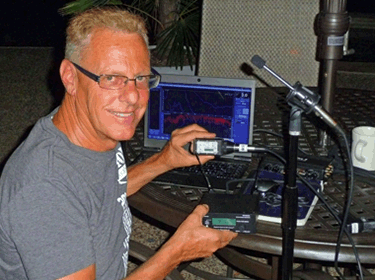Churchill Downs, the thoroughbred racetrack most famous for hosting the annual Kentucky Derby, represents the epitome of professional horse racing. In preparation for the 140th running of the Kentucky Oaks and Kentucky Derby, facility management wanted a new sound reinforcement system installed covering all outdoor areas of the facility. To ensure the new system met the highest expectations, the design services of Dallas, TX-based Marsh/PMK International were retained. And to assist with the many considerations that go into the commissioning of a new sound system, a TM400 Wireless System for Test and Measurement from Rio Rancho, NM-based Lectrosonics was utilized.
A TM400 Wireless System was used for test and measurement.
Marsh/PMK International is the successor firm to Pelton Marsh Kinsella, a well-known consulting firm in the AV marketplace. Marsh/PMK International provides acoustical and audio-video consulting, primarily for the built environment, with projects encompassing everything from hotels/resorts, and convention centers to sports, education, government facilities and themed attractions. David Marsh, the firm’s president, discussed the Churchill Downs project and his experience with the Lectrosonics TM400.
“In October 2013, we were brought in to design a new sound system for Churchill Downs,” Marsh explained. “The new system had to be fully implemented and ready for use by the weekend of May 2nd. The scale of this project and the tight schedule presented significant logistical challenges. These included having to work around horse training and a host of other activities at Churchill Downs during the four weeks or so leading up to the Kentucky Derby. Use of a wireless system was the only practical way to measure in the many different outdoor areas covered by the sound reinforcement system as part of testing, adjusting and final commissioning.”
“We used the Lectrosonics wireless link with an instrumentation quality microphone, the iSEMcon model EMX-7150,” Marsh continued. “The TM400 wirelessly connected the microphone to our Smaart 7 measurement platform, which was used for area-by-area delay setting and system equalization. For equalization, we had to move the microphone around in a given area and average the measurements before moving to another area. One only needs to picture the size and layout of Churchill Downs to appreciate why we had to use a wireless test link.”
Marsh discussed the key considerations that went into his choice of the TM400 over other available options. “Because the wireless system would be used strictly for acoustic and sound system testing, it was of paramount importance that signal integrity be maintained from the input of the transmitter to the output of the receiver,” Marsh said. “It hardly makes sense to use a microphone meeting the tight tolerances of ANSI Type 1 / IEC Class 1 unless the wireless system has a flat frequency response and low noise. Likewise, it was critical that the original signal dynamics be preserved. Any type of dynamics processing—such as companding, commonly found in other wireless systems—would be out of the question. The robustness of the TM400’s RF front-end was important for measurement reliability as was the distance over which the system could reliably transmit. Use of standard XLR connectors at both ends and provision of 48 volt phantom power were icing on the cake.”
“Beyond the TM400 satisfying all of these requirements,” Marsh added, “there is much to say about the Lectrosonics HM transmitter and R400A receiver that constitute the system. The transmitter is solidly made and includes an ‘input coupler’ that is spring-loaded to maintain a noise-free connection to the microphone. It also locks so the microphone cannot accidentally become disconnected. The R400A receiver provides 256 transmission frequencies and an RF scanning utility that quickly finds and sets a clear channel. At Churchill Downs, the transmitter was placed in the stands in a partially covered area near the sound room door. In case of rain, we covered it with a plastic bag leaving just the front panel exposed. Despite this, the receiver got quite wet a few times from rain drops splashing in front of it and yet it kept on working.”
As Marsh needed to get acclimated to the TM400 system quickly, he commented on Lectrosonics’ customer support services, “Soon after receiving the TM400, I wanted a crash course through all the buttons and features with someone guiding me. I called the factory and received one-on-one training. I was up and running in no time!”










